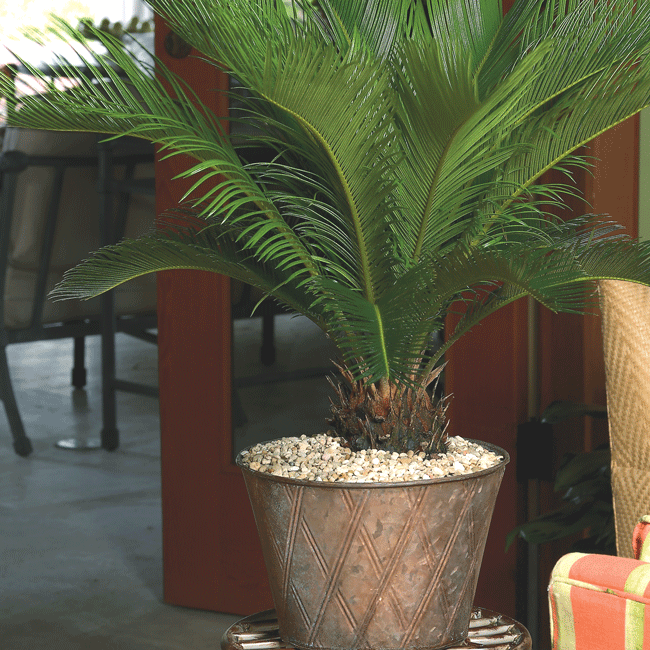
Sago Palm
Cycas revoluta
Care & Maintenance
Plant Code:
L20969hp
Light:
High Light - 3-4 Hours of Indirect Light Per Day
Water:
Water every 2 weeks with 1 cup of water
Bloom Time:
Prized for Foliage
Flower Color:
No flowers
Average Size:
96" H x 48" W
Spacing:
Varies
Cold Hardiness:
Non-hardy below 40°F
About This Plant
Houseplants must be grown inside to survive year after year. This is true for all areas of the world. The size of the inside space can be a multi-story glassed in patio or a kitchen window sill. Houseplants are grown in containers and require extra care. This includes good soil drainage, proper nutrient levels and adequate water. With roots that cannot spread outside the confines of the container, houseplants rely on the attention and care of people to survive. Houseplants come in all types of textures and growth habits for use in the home decor. Using several different growth habits indoors creates an inviting and visually appealing space. Flowering houseplants can provide color and sometimes fragrance. They usually require more sunlight that your typical houseplant in order to bloom successfully. Placing them in high light areas like a sunny window or near a sliding glass door is advisable. Houseplants are even known to improve indoor air quality by absorbing common pollutants.
Additional Information
Poisonous to animals if ingested. Keep away from pets.
Uses
Windows, Offices, Bathrooms
Attributes
- Poisonous to animals if ingested
- It has stiff, spiny fronds
- It is easy to grow
- Good specimen or container plant
How to Water
- Proper watering is crucial to successfully growing houseplants. Knowing when and how much to water is essential.
- In general, it is advisable to allow the soil to dry slightly between watering. This will help prevent over watering; the number one killer of houseplants.
- Notice the feel and color of the soil after a thorough watering. This will help to determine future water needs. Most dry soils have a noticeably different color than moist soil.
- Apply enough water to moisten the entire volume of soil and a little extra to drain through the bottom of the container. This extra water flow will help leach any build up of fertilizer salts from the soil.
- Never allow the container to stand in water. Houseplants that stand in water are more likely to develop disease. All houseplant containers should have drainage holes.
- Use room temperature water when watering houseplants.
How to Plant
- Select a new pot that is 2-3" greater in diameter than the current container. Choosing a pot that is too large can lead to excess soil moisture and an unstable root ball.
- Remove the plant by gently tapping the side to loosen the roots from the container. Never pull on the plant trunk. Instead let the root ball slide out by tipping the container.
- Place a small layer of stones in the bottom of the new container and lightly cover them with a well drained potting mix made for houseplants.
- Set the root ball in the new container. Make sure there is adequate distance between the top of the root ball and the lip of the new container. This will serve as a reservoir while watering.
- Backfill with a potting mix made for houseplants. Gently tap the sides of the container to help remove any air pockets.
- Water thoroughly to settle the soil around the plant. Add more potting mix around plant if necessary after watering. Apply root stimulator to encourage new root growth.
- Lightly top-dress the top of the root ball with the houseplant potting mix.
How to Fertilize
- Fertilize during the plants active growing cycle.
- Choose a fertilizer recommended for Houseplants. Frequency will depend on the type of fertilizer. Liquid (water soluble) and granular quick release fertilizer require more frequent application; slow release granular types require less.
- When using granular fertilizer be sure to sprinkle fertilizer pellets away from the plant stems or trunk to prevent possible burning and always water thoroughly after application. This dissolves or releases the fertilizer into the soil. Apply water soluble fertilizer by thoroughly drenching the leaves and soil.
- Always follow fertilizer package directions.
How to Prune
- Pruning houseplants encourages new growth.
- Prune houseplants while the plant is actively growing. The plant will recover quickly and begin producing new growth.
- For flowering houseplants, remove old flowers as soon as possible.
- When pruning, make angled cuts just above the bud.
- Remove damaged stems and dead leaves from the plant and also from the container.
- Use proper tools such as hand pruners. Make sure all equipment is clean and sharp.
- Fertilize after pruning to help speed new growth.
Resource Center
Product Checklist
- Potting SoilReady to use mix for indoor and outdoor containers and hanging baskets
- Slow Release FertilizerFeeds for months with one application. Safe to use on new plantings
- Planting ToolsShovels, trowels, picks and other tools to make planting easy
- Moisture MeterEasy to use sensor that tells you when your plants are thirsty
- ContainersChoose from light weight resin, clay or ceramic for patio or porch
- Plastic SaucersPlace under decorative containers to protect floors and carpet
- Leaf ShineSafely remove dust and grime from leaves


 We could not acquire a location at this time.
We could not acquire a location at this time.


